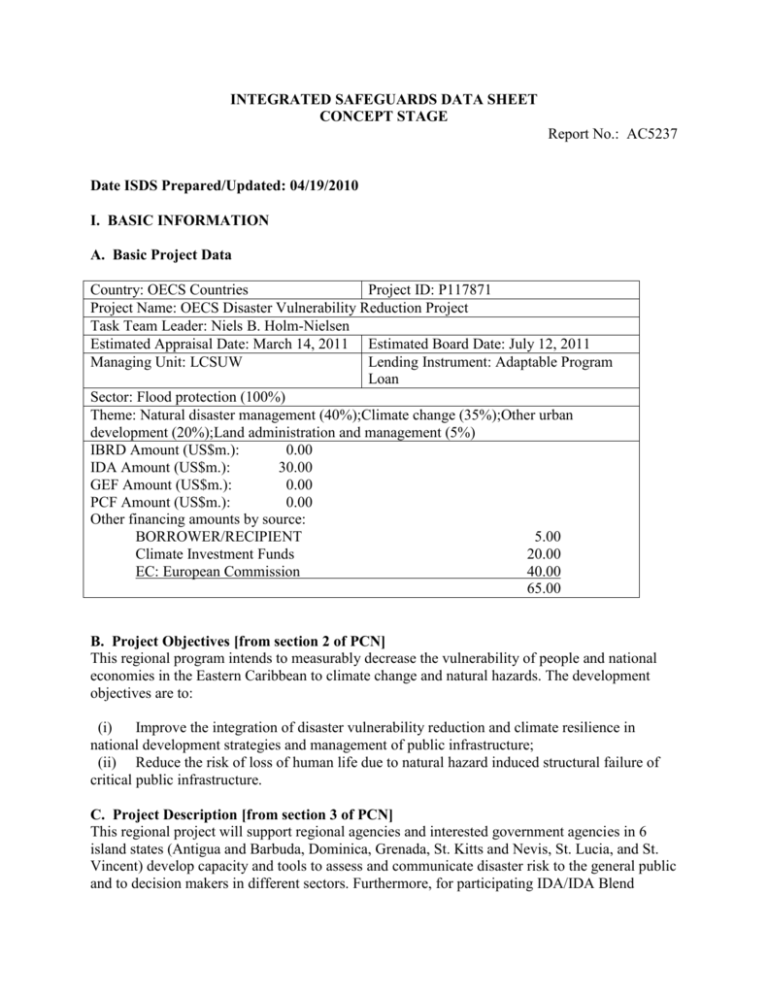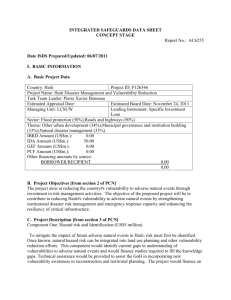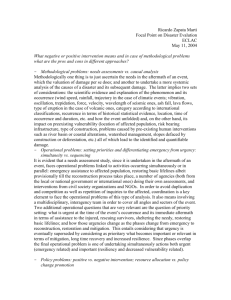Integrated Safeguards Data Sheet - Documents & Reports
advertisement

INTEGRATED SAFEGUARDS DATA SHEET CONCEPT STAGE Report No.: AC5237 Date ISDS Prepared/Updated: 04/19/2010 I. BASIC INFORMATION A. Basic Project Data Country: OECS Countries Project ID: P117871 Project Name: OECS Disaster Vulnerability Reduction Project Task Team Leader: Niels B. Holm-Nielsen Estimated Appraisal Date: March 14, 2011 Estimated Board Date: July 12, 2011 Managing Unit: LCSUW Lending Instrument: Adaptable Program Loan Sector: Flood protection (100%) Theme: Natural disaster management (40%);Climate change (35%);Other urban development (20%);Land administration and management (5%) IBRD Amount (US$m.): 0.00 IDA Amount (US$m.): 30.00 GEF Amount (US$m.): 0.00 PCF Amount (US$m.): 0.00 Other financing amounts by source: BORROWER/RECIPIENT 5.00 Climate Investment Funds 20.00 EC: European Commission 40.00 65.00 B. Project Objectives [from section 2 of PCN] This regional program intends to measurably decrease the vulnerability of people and national economies in the Eastern Caribbean to climate change and natural hazards. The development objectives are to: (i) Improve the integration of disaster vulnerability reduction and climate resilience in national development strategies and management of public infrastructure; (ii) Reduce the risk of loss of human life due to natural hazard induced structural failure of critical public infrastructure. C. Project Description [from section 3 of PCN] This regional project will support regional agencies and interested government agencies in 6 island states (Antigua and Barbuda, Dominica, Grenada, St. Kitts and Nevis, St. Lucia, and St. Vincent) develop capacity and tools to assess and communicate disaster risk to the general public and to decision makers in different sectors. Furthermore, for participating IDA/IDA Blend countries that solicit investment projects, the project will finance investments in disaster vulnerability reduction of public infrastructure and private housing. Climate change models and scenarios will be used to inform risk assessments and assist with the development of improved designs and cost benefit analyses of development activities. The project will help strengthen existing project implementing units, enabling them to execute substantial investments in climate resilience. Funding from the Pilot Program for Climate Resilience (Part of the Climate Investment Fund) made available for the Eastern Caribbean states, as well as grant funding from the European Commission could compliment the sub-regional project. A TWO-TIER APPROACH The regional project in the format of a horizontal APL is a two-tier engagement, which will build on ongoing sub-regional collaboration and result on national investments in risk reduction. The approach is illustrated in Figure 1 below. Tier 1: Sub-regional Collaboration: a. A sub-regional approach to disaster risk reduction takes advantage of the common hazard profile shared by the 6 participating island states. Physical attributes include similar vulnerabilities to sea level rise, intensifying hurricanes and changes in rainfall variability and intensity. Socioeconomic communalities include similar financial challenges (little room for debt financing), ongoing political and financial collaboration through Organization of Eastern Caribbean States Secretariat and the Eastern Caribbean Central Bank, shared scientific community and research capacity through the University of the West Indies, and collaboration with CARICOM institutions on disaster risk management (Caribbean Disaster Emergency Management Agency) and climate change adaptation (Caribbean Community Climate Change Center). b. At a sub-regional level, the proposed engagement will build on the ongoing collaboration among OECS countries (and in particular, the sub-regional states) regarding climate monitoring, hazard identification and monitoring, institutional strengthening and capacity building. Activities will include (i) data collection and establishment of data sharing protocols, (ii) capacity building for generating and interpreting risk assessments, (iii) development and sharing of risk assessment application for policy purposes, (iv) critical infrastructure risk identifications. Tier 2: National Investments: c. The second tier will upon request provide investments for national level infrastructure projects in IDA or IDA blend countries (Dominica, Grenada, St. Lucia, and St. Vincent and the Grenadines), identified through risk assessments, which integrate climate change models and scenarios with existing hazard and vulnerability data. Project Components. National investments in each of the four IDA/IDA blend countries will finance disaster vulnerability reduction organized around the following three components: Component 1. Disaster Risk Identification. Activities will focus on the identification and integration of risk reduction activities and technologies in disaster risk management and development planning. Activities will include the development of baseline data and data infrastructure, risk reduction studies and similar activities, training and workshops in vulnerability reduction and assessment, integration of geospatial technology in risk reduction and studies and training related to vulnerability identification and risk baseline development. In addition to training and institutional development this component may include the purchase of specific hardware and software to improve the analysis and integration of geospatial, risk and vulnerability information within the national development framework and to improve vulnerability reduction and disaster response capacity. Participants under this component may include the National Emergency Management Organization and their local, district and national committees; Ministry of Communications and Works, Ministry of Health, Ministry of Physical Planning, public service authorities and related agencies, and regional institutions. Component 2: Disaster Risk Reduction. Civil works will be executed to include new construction and rehabilitation of existing infrastructure in order to reduce their vulnerability to natural hazards and climate change. Works will be focused on priority public infrastructure. Works will likely focus on transportation, education and health infrastructure and may include activities such as design and construction of a new hospital complex, rehabilitation or new construction of clinic facilities, major road repair or realignment, construction of strategic sea defense works and rehabilitation of replacement of bridges. Included under works is the potential for the design, development and preparation of priority works construction projects to assist the Governments engaging construction funding available from other donors in the region. Other infrastructure related works may include construction of water capture and tank storage capacity and similar activities in the water sector and possible small scale risk reduction activities in electric sector. The project may fund supporting studies required for the development of works packages such as coastal zone studies relating to the design of specific sea defenses, hydrologic/hydraulic investigations, geotechnical investigations and associated pre-engineering and engineering efforts required to support engineering design. During the execution of the works components, specific activities will include the integration of the new building code in the works development process and will introduce hazard/risk analysis and climate change impact analysis to assist in the design and construction of resilient infrastructure. Under an ongoing effort, some of the participating governments have implemented relocation programs to move at risk population to safer environs. The program is focused on communities located in areas where high hazard exists and in many cases have already been exposed to damages from events such as hurricane Ivan, Dean, and most recently (2009) tropical storm Omar. Typically, these areas are currently exposed to recurrent storm surge, severe cliff erosion, landslide exposure and other hazards that pose a recurrent and high probability risk to life and property. The relocation program is variously tailored based on community participation and economic capacity. The project may consider supporting these activities by providing for associated studies, construction design and construction of replacement housing. Component 3: Project management and implementation support. - Activities under this component relate to the institutional support and capacity development for project management and execution. Activities include training, staffing and development activities associated with project execution such as consulting services and support for: a. preparation of preliminary designs and tender invitation documents for all civil, mechanical and electrical works; b. preparation of pre-qualification reports where necessary; c. assistance in the evaluation of tenders, preparation of tender the evaluation reports, selection of the winning bidder and negotiation of contracts; d. supervision of the quality of works. D. Project location (if known) Project works may be undertaken in the principal islands of St. Vincent and the Grenadines such as St. Vincent, Bequia, Canoaun, and Union Island, on Grenada, on St. Lucia and on Dominica. Works contemplated relate to the repair and rehabilitation of existing infrastructure, possible new facility construction, limited application of erosion control and sea defense structures to protect critical infrastructure, possible support for housing construction under existing disaster relocation programs. E. Borrower’s Institutional Capacity for Safeguard Policies [from PCN] Project Coordination Units (PCU) will manage country specific investments projects covering all activities of Tier 2 and some of the activities in Tier 1. PCUs, under the Ministries of Finance in Grenada, St. Lucia and St. Vincent and the Grenadines already have project management capacity and have managed several World Bank projects investing in public infrastructure. The existing PCUs have in the past performed generally satisfactorily and continue to do so. A PCU in Dominica would require additional institutional strengthening assistance if Dominica is to participate in the 2 tier investments. Coordination of safeguard requirements will be managed through the PCUs. A review of past safeguard performance will be conducted during project preparation and addressed in the appraisal stage ISDS. F. Environmental and Social Safeguards Specialists Mr Gerald E. Meier (LCSAR) Ms Tiguist Fisseha (LCSUW) II. SAFEGUARD POLICIES THAT MIGHT APPLY Safeguard Policies Triggered Yes No TBD Environmental Assessment (OP/BP 4.01) X An Environmental and Social Management Framework (ESMF) will be prepared for the project based on candidate subprojects proposed by participating governments. These are expected to be small works focusing largely on rehabilitation of existing infrastructure. There is a possibility that new works will be included and the ESMF will provide procedures for the application of Bank safeguards including information on subproject screening and categorization. The ESMF will provide guidance on the scope of studies necessary to complete for each subproject as well as outline the information required in the necessary subproject Environmental Management Plans (EMPs). If subprojects include hospital or clinic construction and rehabilitation guidance will include handling of medical waste and hazardous waste disposal. The studies and management plans related to each subproject should be completed prior to the start of any works on a particular subproject. Safeguard Policies Triggered Yes No TBD It is likely that the majority of works will be relatively minor in nature. These are works where the environmental impacts are limited to the construction phase. During project preparation the client will develop a technical manual to guide management of construction impacts. This manual will provide guidance on all aspects of construction, including the management of construction camps, disposal of construction waste, management of borrow pits, quarries etc. The manual will be disclosed locally and referenced as a legal covenant in all construction contracts. Natural Habitats (OP/BP 4.04) X No works have been proposed affecting Natural Habitats. Erosion control and sea defense works thus far proposed and focused on mitigating existing landslides to protect public infrastructure. Candidate sea defense works are located in areas of existing landslide and exposed to high energy environments. During project preparation, candidate worksites will be identified and reviewed for potential application of this policy. In the case of future undefined works, this policy along with all other Bank safeguards will be included in the screening procedures provided under the project ESMF. Forests (OP/BP 4.36) X Pest Management (OP 4.09) X There are no plans presently to include subprojects which involve the use the pesticides, herbicides or activities relate to the management of pests. During project preparation, based on the candidate projects proposed and the criteria for including future projects, a final determination will be made regarding the application of this safeguard. In the case of future undefined works, this policy along with all other Bank safeguards will be included in the screening procedures provided under the project ESMF. Physical Cultural Resources (OP/BP 4.11) X While no works have been identifies in sensitive areas, this safeguard is triggered as there is the small likelihood for encountering sites of cultural historical significance, particularly in the case of new construction. Known sites will be identified in the ESFM and assessment and policy implementation requirements will be provided. In the case of small works procedures for chance find will be provided together with appropriate small works contract clauses. Indigenous Peoples (OP/BP 4.10) X Involuntary Resettlement (OP/BP 4.12) X During project preparation, a decision will be made as to whether to support the relocation of persons in high risk areas by assisting with the construction of relocation housing. Additionally, the project may support the relocation of road infrastructure requiring the purchase of private lands. During project preparation, a Resettlement Policy Framework will be prepared and will include the preparation of a social assessment and Resettlement Action Plans as required. If a social assessment is needed it will among other aspects include: (a) a diagnostic analysis of potential impacts and opportunities for communities, taking into account differentiated impacts among various types of vulnerable groups (women, elderly, the disabled, children, etc.); (b) consultation and participatory processes of potentially affected and beneficiary communities; and the findings from this analysis and consultation will be incorporated into the project design and resettlement processes. Safeguard Policies Triggered Safety of Dams (OP/BP 4.37) Projects on International Waterways (OP/BP 7.50) Projects in Disputed Areas (OP/BP 7.60) Yes No X X X TBD Environmental Category: B - Partial Assessment III. SAFEGUARD PREPARATION PLAN A. Target date for the Quality Enhancement Review (QER), at which time the PAD-stage ISDS would be prepared: 11/08/2010 B. For simple projects that will not require a QER, the target date for preparing the PAD-stage ISDS: N/A C. Time frame for launching and completing the safeguard-related studies that may be needed. The specific studies and their timing1 should be specified in the PAD-stage ISDS. ESMF and the Resettlement Policy Framework will be developed prior to appraisal. IV. APPROVALS Signed and submitted by: Task Team Leader: Approved by: Regional Safeguards Coordinator: Comments: Sector Manager: Comments: 1 Mr Niels B. Holm-Nielsen 04/16/2010 Mr Glenn S. Morgan 04/16/2010 Mr Guang Zhe Chen 04/18/2010 Reminder: The Bank's Disclosure Policy requires that safeguard-related documents be disclosed before appraisal (i) at the InfoShop and (ii) in-country, at publicly accessible locations and in a form and language that are accessible to potentially affected persons.






